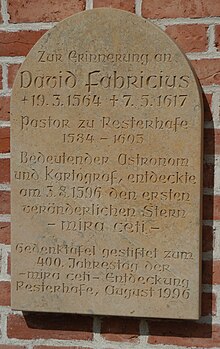David Fabricius
David Fabricius (born March 9, 1564 in Esens ( East Frisia ), † May 7, 1617 in Osteel ) was a theologian , an important amateur astronomer and cartographer . He discovered the variability of the star Mira and was the father of Johann Fabricius , who in 1611 was the first to publish a scientific treatise on sunspots .
Life
David Fabricius was born the son of a blacksmith in Esens. Not much is known about his childhood and youth. He attended Latin schools in the north and probably in Braunschweig . He later noticed that Heinrich Lampadius († 1583) had introduced him to astronomy and mathematics in Braunschweig . After finishing school, he studied, probably in Helmstedt . After a short study period, at the age of 20, he took up an office as a Protestant pastor in Resterhafe near Dornum .
From this time on he was intensively involved with astronomy. He observed the sun , moon , stars, planets , comets and polar lights and entered into correspondence with the great scholars of his time, including Tycho Brahe , Simon Marius and Johannes Kepler . With the latter he exchanged forty letters between 1601 and 1609, which mainly dealt with the planet Mars . He went on numerous trips and became acquainted with important contemporaries. When Tycho Brahe stayed in Wandsbek from 1597 to 1599 , David Fabricius was one of his visitors.
On August 3rd, Jul. / August 13, 1596 greg. Fabricius was the first to notice the variability of the star Omikron Ceti in the constellation Whale . This star changes its brightness with a period of about 331 days , whereby it is clearly visible at the maximum, but becomes invisible to the naked eye at the minimum. Because of this strange behavior, he called the star res mira in letters , since Johannes Hevelius it has been called Mira , the "miraculous". Mira became the namesake of a whole class of long-period variable stars .
In addition to astronomy, Fabricius dealt with meteorology , where he entered his weather observation in a "Calendarium" that has been preserved to this day. He investigated a possible influence of the stars on the movements of the earth's air circle.
In 1589 he produced the first East Frisian map printed in East Frisia under the title "Nie und warhrachtige Beschrivinge des Ostfreslandes" .
Fabricius rose in the favor of his then sovereign and was transferred to Osteel in 1603 .
In 1611 his son Johann (the eldest of seven sons) returned from studying in the city of Leiden and brought a telescope with him. While observing the sun in February 1611, he noticed dark spots. Father and son Fabricius carried out joint observations and were able to determine their existence beyond any doubt. David Fabricius determined the period of rotation of the sun from the movement of the spots on the visible solar disk. Although Galileo Galilei in Pisa and Thomas Harriot in London had already noticed spots on the sun in 1610, at about the same time as Johann Fabricius and Christoph Scheiner in Ingolstadt , Johann Fabricius was the first to write and publish a scientific treatise on this.
The ending of David Fabricius is somewhat curious and shrouded in mystery. Shortly before his death, he is said to have given a sermon in which he claimed to know a goose and chicken thief, but he did not want to reveal his name. A self-made horoscope foresaw disaster for May 7, 1617 and Fabricius spent the day in his house. In the evening he thought the danger was over and went for a walk. On the way he was killed by a farmer, Frerik Hoyer, with a peat spade. Hoyer obviously felt exposed as a thief and was furious about it. He was whacked to death for what he did .
Today a memorial in the cemetery of Osteel and a sandstone plaque on the church of Resterhafe commemorate David Fabricius. The lunar crater Fabricius is named after him.
literature
Entries in reference books
- Johannes Holtmanns: Fabricius, David . In: Allgemeine Deutsche Biographie (ADB). Volume 6, Duncker & Humblot, Leipzig 1877, p. 505 f.
- Willy Jahn: Fabricius, David. In: New German Biography (NDB). Volume 4, Duncker & Humblot, Berlin 1959, ISBN 3-428-00185-0 , p. 731 f. ( Digitized version ).
- Menso Folkerts : David Fabricius . In: Biographical Lexicon for East Frisia . tape 2 . Ostfriesische Landschaftliche Verlags und Vertriebsgesellschaft mbH, Aurich 1997, ISBN 3-932206-00-2 , p. 106–114 ( online [PDF; 104 kB ]).
- Horst-Rüdiger Jarck (Ed.): Braunschweigisches Biographisches Lexikon . 8th to 18th centuries , Braunschweig 2006, ISBN 3-937664-46-7 , p. 211.
Other publications
- Diedrich Wattenberg : David Fabricius. The astronomer of East Frisia (1564–1617) . Archenhold Observatory , Berlin-Treptow 1964.
- Hermann Korte : David and Johannes Fabricius and my father's novel. A biographical story . Aschendorff-Verlag, Münster 2011, ISBN 978-3-402-12890-9 .
- Susanne Ullrich: Father and son leave eternal traces. In: Ostfriesischer Kurier , May 24, 2012, p. 24.
- David Fabricius (March 9, 1564 - May 7, 1617). Astronomer, cartographer, astrologer and weather observer (= Oll 'Mai - series of publications - published by the Ostfriesische Landschaft . Volume 11 ). Ostfriesische Landschaftliche Verlags- und Vertriebsgesellschaft mbH, Aurich 2017, ISBN 978-3-940601-42-1 ( online [PDF; 11.9 MB ]).
Web links
- Literature by and about David Fabricius in the catalog of the German National Library
| personal data | |
|---|---|
| SURNAME | Fabricius, David |
| BRIEF DESCRIPTION | German theologian, amateur astronomer and cartographer |
| DATE OF BIRTH | March 9, 1564 |
| PLACE OF BIRTH | Esens |
| DATE OF DEATH | May 7, 1617 |
| Place of death | Osteel |

